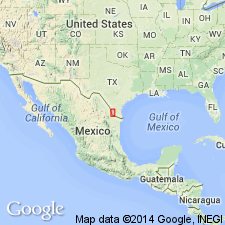
- Usage in publication:
-
- Villa Nueva sandstone member
- Modifications:
-
- Original reference
- Dominant lithology:
-
- Sandstone
- AAPG geologic province:
-
- [Gulf Coast basin]
Summary:
Pg. 1387. Villa Nueva sandstone member of Fayette formation. Uppermost beds of Fayette formation that admit of measurement, in section measured on both sides of Rio Grande between Roma and Rio Grande City, [Starr Co.], southern Texas. Consists of 63 feet of coarse-grained soft gray sandstone commonly weathering brown, with, at base, a fossiliferous horizon containing species of TURRITELLA, VOLUTOCORBIA, and other fossils. [Age is late Eocene.]
[Origin of name not stated. Recognized in Tamaulipas, northeastern Mexico.]
Source: US geologic names lexicon (USGS Bull. 896, p. 2249).

- Usage in publication:
-
- Villa Nueva sandstone member
- Modifications:
-
- Areal extent
- AAPG geologic province:
-
- Gulf Coast basin
Summary:
Pg. 259 (fig. 2), 270. Villa Nueva sandstone member of Fayette formation. In Starr County, southern Texas, overlies Agua Verde shale member (new). Exposures limited. Thickness probably more than 100 feet. Appears to be overlapped by Frio just south of Zapata County line. Age is late Eocene.
Source: Publication; US geologic names lexicon (USGS Bull. 1200, p. 4081-4082).
For more information, please contact Nancy Stamm, Geologic Names Committee Secretary.
Asterisk (*) indicates published by U.S. Geological Survey authors.
"No current usage" (†) implies that a name has been abandoned or has fallen into disuse. Former usage and, if known, replacement name given in parentheses ( ).
Slash (/) indicates name conflicts with nomenclatural guidelines (CSN, 1933; ACSN, 1961, 1970; NACSN, 1983, 2005, 2021). May be explained within brackets ([ ]).

